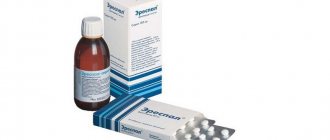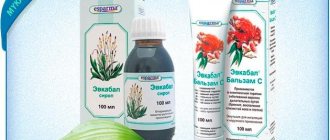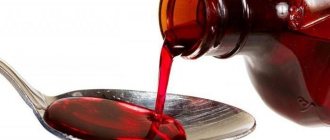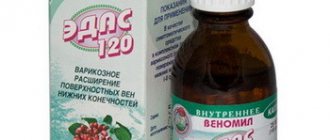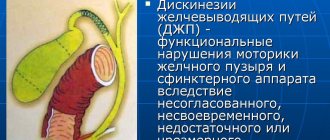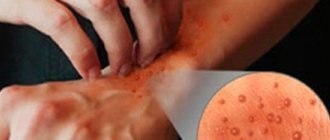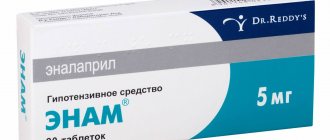Broncholithin is a herbal remedy that is used to treat various diseases of the lungs and bronchi.
The drug is available in the form of syrup in bottles. The active ingredients of the drug are ephedrine hydrochloride and glaucine hydrobromide. Bronholitin syrup also contains auxiliary components such as basil oil, anhydrous citric acid, 96 percent ethanol, methyl parahydroxybenzoate, sucrose, purified water, polysorbate 80 and propyl parahydroxybenzoate.
Pharmacodynamics and pharmacokinetics
This combined agent exhibits a high antitussive and bronchodilator effect. Its action is determined by its constituent components.
Glaucine hydrobromide is able to suppress the cough center without causing respiratory depression , drug dependence , the development of constipation and other undesirable effects.
Taking ephedrine leads to dilation of the bronchi, helps stimulate breathing, exhibiting a vasoconstrictor effect, which helps eliminate swelling of the mucous membranes of the bronchi.
Basil oil has some sedative, antimicrobial and antispasmodic effects.
Once in the body, the drug undergoes good absorption from the gastrointestinal tract, showing maximum effect after 1.5 hours. The metabolic takes place mainly in the liver, and is excreted from the body in urine.
Pharmacological action of Broncholitin
According to the instructions, Bronholitin is a combination drug that has an antitussive effect and helps improve the patency of the respiratory canals.
Glaucine hydrobromide, which is part of the drug, suppresses the cough center without depressing breathing. Also, the substance does not cause drug dependence.
Ephedrine is the second active component of Broncholitin. Its action is aimed at dilating the bronchi, stimulating breathing and eliminating swelling of the mucous surfaces of the bronchi due to its vasoconstrictor properties.
Basil oil (auxiliary component) has minor antimicrobial, sedative and antispasmodic effects.
After using Bronholitin orally, its active components are well and rapidly absorbed by the walls of the gastrointestinal tract. The maximum concentration of glaucine hydrobromide is achieved one and a half hours after administration. This component is metabolized by the liver and is excreted mostly in the urine. Ephedrine, in turn, is excreted unchanged from the body in the urine. T1/2 is 3-6 hours.
Indications for use
The drug Bronholitin is a cough syrup, which is recommended for use as part of complex therapy for diseases of the respiratory system accompanied by dry cough , for example, with:
- acute inflammation of the upper respiratory tract;
- tracheobronchitis;
- acute and chronic forms of bronchitis;
- bronchial asthma;
- pneumonia;
- bronchiectasis;
- whooping cough
Cough as the main symptom of respiratory diseases
Cough is a symptom of most respiratory tract diseases [1] and one of the most common complaints with which a patient consults a doctor. There are more than 50 causes of cough. These include acute respiratory diseases (pharyngitis, laryngitis, tracheitis), pathology of the bronchopulmonary system (bronchitis, pneumonia, pleurisy, obstructive pulmonary diseases), whooping cough, diseases of the paranasal sinuses, heart, lymphatic system organs, as well as mediastinal tumors. Cough may occur due to exposure to certain medications), toxic compounds, inhalation of irritants, and aspiration. Cough is caused by irritation of the irritant receptors of the “cough zones” of the posterior wall of the pharynx, glottis, trachea and pleura, as well as cough receptors of the nasal cavity and middle ear. In all conditions where cough is a symptom, inflammatory swelling of the mucous membrane develops and a pathological secretion is formed. Cough is classified as follows: by nature - dry, hacking and productive (with sputum production); by duration - episodic, short-term, paroxysmal and constant; according to the course – acute and chronic.
Cough is a symptom that brings physical and/or psychological discomfort, disrupts sleep and significantly reduces the patient’s quality of life. Frequent debilitating chronic cough can lead to increased intrathoracic pressure, pulmonary emphysema, and the formation of cor pulmonale. Treatment of cough should begin from the moment it loses its physiological purpose. An unproductive or unproductive cough must be eliminated with the help of medications, which can lead to a noticeable improvement in the patient’s well-being and the course of the disease. Thus, the use of antitussives occupies an important place in the treatment of the underlying pathology and is one of the leading areas of symptomatic therapy.
Classification of antitussive drugs
Antitussives are divided into two main groups: drugs of central and peripheral action. There are also combination medications. Among the antitussive drugs of central action that suppress the function of the cough center of the medulla oblongata, narcotic (codeine) and non-narcotic (glaucine, prenoxdiazine, oxeladine, butamirate) are distinguished. Non-narcotic drugs are used more often due to their lack of undesirable effects such as addiction, respiratory depression, and weakened intestinal motility. Combination drugs, as a rule, include a centrally acting drug, a vasoconstrictor and sometimes a bronchodilator component. They often contain antihistamines, expectorants and/or antipyretics.
Pharmacological effects of Broncholitin components
Bronholitin, produced in the form of 125 g syrup (Sopharma, Bulgaria), is a combined drug that has an antitussive and sympathomimetic effect. Broncholitin inhibits the cough center in the central nervous system without respiratory depression, relieves bronchospasm, reduces bronchial secretion, has antispasmodic, secretolytic, mild antiseptic and sedative effects. Can be used either alone or in combination with antibacterial and anti-inflammatory drugs. It is used to treat dry, unproductive, obsessive cough, as well as when cough is combined with broncho-obstructive syndrome. The active ingredients of Broncholitin are glaucine hydrobromide and ephedrine hydrochloride (5.75 mg and 4.6 mg in 5 ml of syrup, respectively). The syrup contains the following excipients: basil oil, citric acid anhydride, methyl hydroxybenzoate, propyl parahydroxybenzoate, sucrose, polysorbate 80, ethanol 96% (1.7 vol.%), purified water.
Glaucine hydrobromide is an effective antitussive non-narcotic drug of central action, an alkaloid of the yellow poppy plant (Glaucium flavum Crantz). Selectively inhibits the cough center of the medulla oblongata, without causing, unlike narcotic analgesics, depression of the respiratory center, addiction and drug dependence, without having an inhibitory effect on intestinal motility. Additional effects of glaucine are a decrease in bronchial reactivity and a decrease in bronchospasm due to the selective inhibition of phosphodiesterase type 4 and the effect on Ca2+ influx [2–4]. Glaucine has weak adrenergic blocking properties and may lower blood pressure (BP).
When taken orally, glaucine is quickly and completely absorbed from the gastrointestinal tract. The time to reach maximum plasma concentration is 90 minutes. Metabolized in the liver and excreted primarily in the urine [2].
Ephedrine hydrochloride belongs to the group of indirect-acting sympathomimetics. It enhances the release of norepinephrine from the endings of adrenergic nerves and inhibits its reuptake. Due to this, ephedrine has a stimulating effect on β- and β-adrenergic receptors. Causes bronchodilation as a result of stimulation of β2-adrenergic receptors of the bronchial muscles [2].
Ephedrine increases the excitability of the respiratory center. It is one of the first decongestants - its anti-edematous effect is due to stimulation of α1 receptors in the vessels of the respiratory mucosa. The same mechanism underlies the increase in blood pressure, and stimulation of the β1 receptors of the heart is manifested by an increase in heart rate (HR).
Ephedrine, causing undesirable central effects, is capable of forming pathological addiction and addiction (included in list A). Ephedrine hydrochloride is well absorbed from the gastrointestinal tract and does not bind to plasma proteins. Slightly metabolized in the liver, excreted in the urine mainly unchanged. The half-life is 3–6 hours [2, 5, 6]. Basil oil inhibits the cough reflex and has a moderate bronchodilator and antiseptic effect.
Thus, the drug Broncholitin uses a rational combination of components such as glaucine, ephedrine and basil oil. Glaucine and basil oil suppress the cough reflex. Glaucine in combination with ephedrine provides antitussive, bronchodilator and decongestant effects simultaneously. The action of this combination is especially effective in cases of pathological cough with inflammation and swelling of the mucous membranes, associated with increased bronchial reactivity and bronchospasm. These components of Broncholitin act in a mutually balanced manner on the cardiovascular system: ephedrine increases blood pressure and heart rate, and glaucine lowers them.
Contraindications
Taking the drug is contraindicated if:
- arterial hypertension;
- IHD;
- severe forms of organic heart disease;
- pheochromocytoma;
- heart failure;
- thyrotoxicosis;
- early pregnancy ;
- insomnia;
- prostatic hyperplasia , which is accompanied by clinical manifestations;
- lactation;
- patients aged less than 3 years;
- angle-closure glaucoma;
- sensitivity to the drug.
Caution is necessary if you are prone to drug addiction. Since the drug contains ethanol, caution is required when prescribing to children, patients with liver disease, epilepsy, chronic alcoholism, and brain disorders.
Clinical effectiveness of Bronholitin and its components
The therapeutic effectiveness of individual components of the drug Broncholitin or their combination has been studied in a number of clinical studies in the complex treatment of acute and chronic bronchitis, bronchial asthma and whooping cough.
In 1984, the first clinical studies of the comparative antitussive effectiveness of glaucine and codeine were conducted. Glaucine was used in the form of syrup at a dose of 30 mg 3 times a day for 7 days. The study confirmed the good antitussive effect of glaucine, comparable to that of codeine [7].
Further clinical studies of glaucine were conducted in 130 patients with acute and chronic cough due to acute respiratory infections, bronchitis and complicated respiratory infections. Glaucine was administered in capsule form at a dose of 30 mg 3 times daily for 28 days. A good antitussive effect of the drug was noted and it was well tolerated; no adverse drug reactions (ADRs) were observed [8].
In 1983, Constant O. et al. used high doses of glaucine in patients with bronchopulmonary diseases. The authors found that glaucine can depress respiration due to a sedative effect, but, unlike codeine, only in very high doses [9]. Such doses of glaucine are not used in the drug Broncholitin.
The use of an inhaled form of glaucine in patients with bronchial asthma led to a decrease in bronchial reactivity during drug provocative tests and tests with allergens [10, 11].
Currently, glaucine is assessed as a very well tolerated drug [7, 12], which does not cause the development of drug dependence [13].
Clinical studies of the therapeutic effectiveness of Broncholitin were conducted in three clinics of the Sofia Medical University (Bulgaria) in 36 patients suffering from chronic obstructive bronchitis. As part of complex therapy, they received Bronholitin 15 ml 3 times a day. The effectiveness of the treatment was assessed by changes in the frequency and intensity of cough, the quantity and quality of sputum, and respiratory functions. The results obtained allowed us to conclude that Bronholitin is quite effective. By the 10th day of treatment, cough completely disappeared in 15 (42%) patients, and in 21 (58%) patients there was a decrease in its frequency and intensity (“slight cough”). The disappearance of shortness of breath by the 10th day of treatment was noted in 24 (67%) patients. This therapeutic effect was confirmed by the results of a study of the function of external respiration - there was an increase in parameters such as vital capacity of the lungs, forced vital capacity of the lungs, as well as normalization of the acid-base composition and blood gases. Clinical studies of Broncholitin in children were conducted at the University Clinic of Children's Pulmonary Diseases (Sofia, Bulgaria). Thirty children diagnosed with acute bronchitis aged 3 to 14 years received Bronholitin on an outpatient basis for 10 days in age-appropriate doses, 26 of them were also prescribed antibacterial therapy. By the 10th day of treatment, only 3 patients still had a slight cough. It was concluded that Bronholitin is an effective antitussive agent in the complex therapy of children with diseases of the respiratory system.
Clinical studies have shown that in therapeutic doses Bronholitin is well tolerated by both adults and children. This is due to the use of a relatively low dose of ephedrine in the drug: the recommended single dose of Broncholitin for adults (10 ml) contains 9.2 mg. For comparison: one tablet of ephedrine contains 25 mg of this substance, and one tablet of Theophedrine contains 20 mg.
When using Broncholitin, ADRs may occur, which are usually due to the pharmacodynamic effects of ephedrine. The risk of their development is higher in patients with cardiovascular diseases. ADRs can manifest as increased blood pressure, tachycardia, arrhythmia, headache, and insomnia. When using very high doses (overdose of the drug), tremors, convulsions or mental disorders may occur. Taking high doses of Bronholitin in patients with coronary artery disease is associated with a risk of developing acute myocardial infarction. Ephedrine may cause urinary retention in patients with prostatic hyperplasia.
Bronholitin is taken orally with a small amount of liquid during or after meals. Adults are prescribed 10 ml 3-4 times a day, children from 3 to 10 years old - 5 ml 3 times a day, children over 10 years old - 10 ml 3 times a day.
Conclusion: Broncholitin is an effective combination drug
Broncholitin is an effective combination drug intended for the symptomatic treatment of cough in acute and chronic respiratory diseases - laryngitis, bronchitis, bronchial asthma, whooping cough - as a component of complex therapy. The active ingredients of Broncholitin are the apomorphine alkaloid glaucine and the sympathomimetic ephedrine, which have antitussive, bronchodilator and systemic decongestant (decongestant) effects. The combined use of these components weakens or eliminates non-productive cough, bronchoconstriction, and reduces swelling of the mucous membrane of the respiratory tract. The use of Broncholitin is especially indicated for pathological processes accompanied by inflammation, increased bronchial reactivity and/or bronchospasm.
Contraindications to the use of Broncholitin are due to some pharmacodynamic effects of ephedrine. It should not be used in patients with arterial hypertension, severe heart disease (especially those complicated by heart failure, arrhythmia), in particular, acute myocardial infarction. It is not recommended to use Bronholitin in hyperthyroidism and diabetes mellitus, in patients with benign prostatic hypertension, glaucoma, or in case of hypersensitivity to the components of the drug. Broncholitin is contraindicated in the first trimester of pregnancy and lactation. In the second and third trimesters of pregnancy, it can be used with caution. The drug should not be prescribed to children under 3 years of age.
LITERATURE Samsygina G.A. Antitussive therapy: a rational choice // In the world of drugs. 1999. No. 2. Goodman & Gilman's The Pharmacological Basis of Therapeutics. 1996. IvorraMD, LugnierC, SchottC, et al. Multipleactionsofglaucineoncyclicnucleotidephosphodiesterases, alpha 1-adrenoceptorandbenzothiazepinebindingsiteatthecalciumchannel. Br J Pharmacol 1992;106(4):1041. Orallo F, Alzueta FA, et al. Study of the in vivo and in vitro cardiovascular Effects of (+)-glaucine and N-carbethoxysecoglaucine in rats. Br J Pharmacol 1995;114(7):1419–27. British National Formulary (BNF), sept. 2000, 40th Ed., Derby, Great Britain, Br Med Ass and the Royal Pharmac Soc of Great Britain. Dollery C. Therapeutic Drugs. Churchill Livingstone, Edinburgh, London etc., 2000;1. Castpar H, Criscuolo D, Dieterich HA. Efficacy and tolerance of glaucine as an antitussive agent. Curr Med Res Opin 1984;9(1):21–27. Irwinet RS, et al. In: Chest, 1998. Constant O, Slavin B, et al. Effect of the antitussive glaucine on bronchomotor tone in man. Thorax 1983;38(7):537–42. Pons R, Santamaria P, et al. Effects of inhaled glaucine on pulmonary responses to antigen – sensitized guinea pigs. Eur J Pharmacol 2000;397(1):187–95. Cortijo J, Villagrasa V, et al. Bronchodilator and anti-inflammatory activities of glaucine: in vitro studies in human airway smooth muscle and polymorphonuclear leukocytes. Br J Pharmacol 1999;127(7):1641–51. Ruhle KH, et al. Objective evaluation of dextromethorphan and glaucine as antitussive agents. Br J Clin Pharmacol 1984;17(5):521–24. Schuster CR, et al. Experimental studies of the abuse potential of d,l-glaucine,1,5 phosphate in rhesus monkeys. Pharmacol Biochem Behav 1982;16(5):851–54.
Side effects
When treated with Bronholitin, side effects may occur that affect the functioning of the cardiovascular, nervous, digestive, endocrine, urinary and other systems. In this case, undesirable effects often occur in the form of: tachycardia, extrasystole , increased blood pressure , tremor , agitation, insomnia , dizziness , nausea , vomiting, anorexia , constipation , increased libido, dysmenorrhea , difficulty urinating and others.
It is also possible that vision impairment, the development of dermatological reactions, tachyphylaxis , and so on.
Side effects of Bronholitin
From reviews of Broncholitin, the following adverse reactions from the body are known:
- From the cardiovascular system: increased blood pressure, tachycardia and extrasystole;
- From the senses: disruption of the visual organs;
- From the central nervous system: insomnia, agitation, tremor, dizziness, drowsiness (in children);
- From the endocrine system: dysmenorrhea and increased libido;
- From the digestive system: nausea, constipation, vomiting and anorexia;
- From the urinary system: urinary retention in patients with prostate adenoma, difficulty urinating;
- Skin reactions: rash, increased sweating;
- Other manifestations: tachyphylaxis.
If the dose of the drug is exceeded or taken for a long time, an overdose is observed, which is accompanied by symptoms such as:
- Nausea and vomiting;
- Tremor of the limbs;
- Dizziness;
- Urinary retention;
- Poor circulation;
- Appetite suppression;
- Excessive excitement.
In such a situation, it is necessary to rinse the stomach and take sorbents.
Bronholitin syrup, instructions for use (Method and dosage)
This drug is intended to be taken orally after eating. As the instructions for use of Broncholitin for children indicate, it can be used from 3 years of age.
In this case, the daily dosage for children 3-10 years old is 5 ml for 3 times a day. For adult patients and children over 10 years of age, the instructions recommend taking the syrup in a daily dosage of 10 ml 3-4 times.
The duration of therapy is on average 5-7 days, and reviews for children show that this time is quite enough for a complete recovery.
Bronchitis - treatment of bronchitis
Acute bronchitis is an inflammatory process in the bronchial mucosa. Bronchitis is often combined with inflammation of the nose, throat, larynx, and trachea. Moreover, the process of bronchitis begins from the nasopharynx and descends through the respiratory tract. The development of the disease bronchitis is promoted by exhaustion, overwork, neurophysical stress, hypothermia, dustiness, gas pollution, alcoholism, smoking, contact with patients in the family and at work, on the street, in the subway.
Cough and sputum are the main complaints with bronchitis. In the case of inflammation of the small bronchi (bronchioles), bronchitis is associated with shortness of breath and suffocation, which is already a consequence of the transition of bronchitis to asthma. Untreated acute bronchitis becomes chronic. The disease of chronic bronchitis lasts a long time (months, years and decades) with periods of exacerbation and remission. The main symptom of chronic bronchitis is a cough with mucous or mucopurulent sputum.
Bronchitis is more common in areas with a humid climate, among workers in damp rooms, etc. Bronchitis affects mainly children and the elderly, with men more often than women.
Causes of bronchitis
The leading factor in the occurrence of bronchitis is viral (influenza, parainfluenza, adenoviruses) and bacterial (streptococci, pneumococci, Haemophilus influenzae, etc.) infections. In some cases of bronchitis, a secondary bacterial infection is associated with a viral infection. Predisposing factors for bronchitis include hypothermia, smoking, alcohol consumption, chronic focal infection in the nasopharyngeal area, impaired nasal breathing, and chest deformation.
Symptoms of bronchitis
The main symptom of bronchitis is a cough (dry or wet). In acute bronchitis, the cough is predominantly paroxysmal in nature, accompanied by a feeling of burning or rawness behind the sternum or in the throat. Sometimes the cough is so intense that it is accompanied by a headache. Patients are concerned about weakness, chills, fever up to 37-38 ° C, headache, muscle pain.
Diagnosis of bronchitis
Diagnosis of bronchitis is based on typical complaints and examination of the patient by a doctor. There are no typical radiological and laboratory signs of bronchitis (there may be an increase in the pulmonary pattern in the root region and a moderate increase in the number of leukocytes in the blood).
Treatment of bronchitis
In case of acute bronchitis, semi-rest or bed rest, increased nutrition, plenty of warm drinks (tea with raspberry jam or honey, milk with soda or half with mineral water, raspberry infusion, linden blossom) are necessary. Smoking is strictly prohibited. The use of cups, mustard plasters on the chest and back, and pepper plaster is possible only with the permission of a doctor. Anti-inflammatory drugs (aspirin, paracetamol, etc.) and expectorant drugs, broncholithin, are used.
If there is purulent discharge during bronchitis, it is advisable to prescribe antibacterial agents. Only a doctor should prescribe antibiotics. Self-medication with antibiotics can be ineffective and dangerous.
Interaction
This drug contains ephedrine, which can reduce the effectiveness of hypnotics and opioid analgesics.
Concomitant use with cardiac glycosides, tricyclic antidepressants and Quinidine can lead to the development of arrhythmias .
Combination with Reserpine or MAO inhibitors significantly increases blood pressure, and with non-selective beta-blockers reduces the bronchodilator effect of the drug.
Cross-drug interactions
Bronholitin can be combined with antibiotics and antibacterial substances, as well as medications that relieve pain and fever.
The medicine can be taken with vitamins.
Taking sympatholytics reduces their hypotensive effect.
It acts negatively with cardiac drugs and antidepressants, which often causes arrhythmia.
Reduces the effects of sleeping pills and narcotic medications.
Beta blockers significantly reduce the effect of the active substance.
special instructions
You should know that one measuring spoon or glass, the volume of which is 5 ml, contains about 0.069 g of 96% ethanol.
When driving vehicles and operating machinery, dizziness may occur and vision may be impaired, so you need to be careful when performing work that requires high attention and quick psychomotor reactions.
Treatment of patients with impaired liver function also requires extreme caution when choosing a therapeutic regimen and course duration.
Release form and composition
The medication is available in the form of a syrup for oral administration from light yellow to light brown or yellow-green in color, with a specific odor of basil oil.
5 grams of syrup contains:
- 5 mg glaucine hydrobromide;
- 4 mg ephedrine hydrochloride;
- Excipients: polysorbate 80, methyl parahydroxybenzoate, 96% ethanol, sucrose, propyl parahydroxybenzoate, purified water, anhydrous citric acid, basil oil.
Syrup is sold in 125 g bottles of dark glass or polyethylene terephthalate, complete with a measuring cup or spoon.
Broncholitin analogs
Level 4 ATC code matches:
Bronchoton
Pectolvan Stop
Glycodin
The main analogues of Broncholitin, similar in mechanism of action: Bronchocin, Broncholin sage, Bronchoton, Codipront, Tussin Plus, Tedein, Alex Plus, Tercodin, Glycodin . If the patient has a problem, what to replace the drug with is better to discuss this with the attending physician.
Analogs
If necessary, it is possible to replace Bronholitin with the following means:
- Antitussive drug Codelac Neo. It has a spasm-relieving and cough-stopping effect.
- Omnitus is a one-component medicinal product (the active ingredient in it is the same as in Broncholitin).
- Bronchitusen Vramed syrup based on the same ephedrine, glaucine and basil oil.
- A drug with similar components Bronchoton.
- Sinekod is a butamirate-based product that dilates the bronchi and suppresses the cough reflex.
Before using Bronholitin analogues for children or adults, consultation with a specialist is required.
Bronholitin for weight loss
Quite often, this drug is taken by women who want to quickly and completely lose weight. In this case, a special scheme for weight loss is used, including: Caffeine , Broncholithin, Aspirin , which are taken in certain dosages.
Reviews about this method of losing weight vary and are not always positive. For many people, this results in serious health problems, but this stops few people. Also, regimens using this drug are used in bodybuilding, when it is necessary to influence the development of muscle mass and body structure.
Precautionary measures
Broncholitin should be used with caution in patients suffering from serious sleep disorders.
Also, prescribing the drug to people with severe kidney, liver, brain diseases and epilepsy requires careful supervision by a specialist.
The presence of ethanol in the medicine requires caution when used in childhood.
There is a possibility of the drug influencing the control of vehicles and mechanized vehicles.
Reviews about Bronholitin
In most cases, reviews about Broncholitin are found on medical forums, but users also leave opinions about this drug on other resources. However, they are not always related to its intended use.
Unfortunately, many reports concern how to obtain ephedrine for use as a narcotic substance. There are also many schemes for using the drug in combination with other drugs.
It is not surprising that all this causes a storm of indignation. Many users sincerely do not understand how they can buy this highly effective drug, which helps patients with bronchial asthma , only to knock out the ephedrine and use it for other purposes. Usually such experiments end in serious complications. As a result, the health of the liver and kidneys, cardiovascular and other body systems suffers.
You can also find reviews of Broncholitin for children, when this drug was used in the treatment of bronchial asthma, obstructive bronchitis and other diseases. The treatment usually goes well, but some mothers are interested in whether Bronholitin is available in pharmacies by prescription or not? As you know, it is almost impossible to buy this drug without a prescription. Moreover, syrup is not at all easy to purchase in pharmacies, even with a prescription, so some patients prefer tablets, which are more affordable.
Thus, reports regarding the use of the drug according to its indications indicate its high effectiveness. Cases of side effects have not been described. But still, it is not recommended to take this medicine without a doctor’s prescription.
Review Reviews
There are many reviews about Bronholitin on medical websites; almost all of them note its effective help in fighting coughs.
Patients say that the syrup acts instantly and relieves a severe attack of dry cough within 15 minutes. A day after the start of treatment, the cough passes into the productive stage, wheezing and whistling disappear. Some note that a course of taking Broncholitin helped in the treatment of obstructive bronchitis; people even stop using inhalers.
Many mothers, in reviews of the use of Broncholitin for children, share their observations that at the end of the first day the cough becomes less barking and gradually goes away. The dry cough gradually turns into a wet cough and by the end of the week's course it is possible to get rid of it completely.
Bronholitin price, where to buy
The price of syrup in Russian pharmacies starts from 95 rubles. You can also buy Bronholitin with delivery, after finding out how much the drug costs by phone or on the company’s website.
The price of Bronholitin in Ukraine varies between 60-70 UAH.
- Online pharmacies in RussiaRussia
- Online pharmacies in UkraineUkraine
- Online pharmacies in KazakhstanKazakhstan
ZdravCity
- Broncholitin syrup 125gSopharma AD
RUB 152 order
Pharmacy Dialogue
- Bronholitin (vial 125g)Sopharma
RUB 171 order
show more
Pharmacy24
- Bronholitin 125 ml syrup AT "Sopharma", Bulgaria
99 UAH. order - Broncholitin 40 mg No. 20 tablets AT "Sopharma", Bulgaria
103 UAH order
PaniPharmacy
- Bronholitin liquid Bronholitin syrup 125ml Bulgaria, Sopharma
113 UAH order
- Bronholitin tablets Bronholitin tablets. 40 mg No. 20 Bulgaria, Sopharma
107 UAH order
show more
